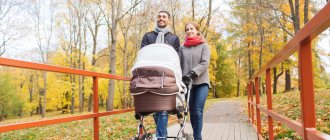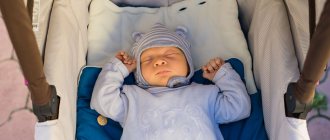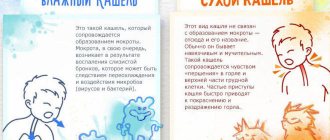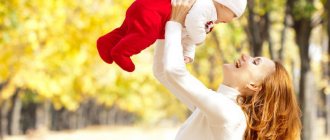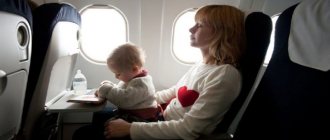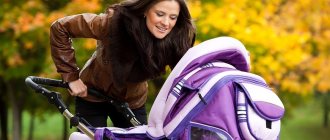Why is it important to go for a walk with your child?
- We replenish the need for oxygen. Outdoors, the oxygen content is much higher than in a room. In winter, batteries and heaters additionally dry the air and reduce the content of precious gas.
- Fresh air. The indoor air contains a large number of bacteria, dust, allergens, and household chemicals.
- We stimulate the immune system. Walking is one of the ways to harden the body. The difference between the temperature in the room and outside stimulates the defense mechanisms of the baby's immune system.
- We prevent the development of rickets. Vitamin D is produced in the baby's skin when exposed to ultraviolet light. Even if the day is not entirely clear, a half-hour walk will significantly increase the level of vitamin D and help strengthen the musculoskeletal system.
- Walking is educational. On the street, the baby explores the world around him. The newborn receives new sensations, visual and sound images. An older child finds friends and learns to interact in society.
- Benefit for mom. Physical activity helps to regain shape after childbirth and adjust weight. Walking is an opportunity to find new friends and share parenting secrets. Communication and support among women reduces rates of postpartum depression.
- Interesting pastime. Walking is another opportunity for mother and baby to spend time together.
Balcony or street?
This issue often becomes a topic for active discussion and even debate. What to choose for walks with your child in winter: a balcony or the street? Is a balcony a complete alternative to walking outside?
Now we will look at everything in detail, but first answer the following questions :
- Is your balcony located on a quiet side of the house, away from highways?
- Do you live on the fifth, sixth or seventh floor?
- If your floor is above the seventh, are there no factories, state district power plants, thermal power plants or other industrial enterprises in the immediate area?
If you answered yes to the first and second or first and third questions and your baby is still sleeping during the walk, then in the winter the balcony can become a full-fledged alternative to walks. Just make sure that no one smokes on the balcony below or nearby, and that the neighbor above does not throw a cigarette butt!
For information:
From 1st to 4th floors . Exhaust gases accumulate. The maximum concentration of gases is kept at the level of the third floor. But trees grow outside the windows. In the shade of trees, grass grows poorly, and often the lawn under the apartment windows turns into a constantly dusty surface.
5-7th floor . Exhaust gases do not rise above the fifth floor. From the seventh and above there is an accumulation of harmful substances from the pipes of enterprises.
17th floor and above . Electromagnetic radiation. The reinforced concrete structure of the house does not allow electric waves to pass through, forcing them to circulate throughout the apartment and transmitting part of the background to higher floors. The higher the floor, the stronger the cumulative background.
Important! Everyone understands perfectly well that a child older than five to six months should be walked outside. The balcony can only be used for baby's sleep.
The child should receive new impressions and emotions . This is important for his intellectual and psychological development. Probably, each of us paid attention to the little ones peeking out of their strollers; it’s very touching to see with what interest they study the world around them. In addition, walks outside are important for the socialization of the baby.
Walking allows your baby to get the dose of vitamin D necessary for the body, even on a cloudy day.
There is one more point. Walking outside is an excellent prevention of vision problems , including myopia. The fact is that when on the street, the child constantly moves his gaze from nearby objects to objects located in the distance and back, and this is a kind of eye training that strengthens the baby’s vision.
Still, you shouldn’t arrange all your walks on the balcony. Mom needs fresh air too . Walking strengthens the mother's body and allows her to quickly get into shape after childbirth. And also, a mother on the street can team up for joint walks with other mothers. And sitting at home, you won’t get communication.
Interesting things on the site:
Types of balcony railings
How to get rid of pigeons on the balcony
How to remove a hive with wasps from the balcony
When can you start walking with your newborn?
It all depends on the time of year when the child was born. If the baby was born in the summer or spring, it is enough to wait 5 - 7 days and begin the first travels. In the cold season you will have to wait for 2 weeks.
You should not go outside if the air temperature drops below minus 10 degrees or rises above 30.
The first walk should not last more than 10 minutes. Place the baby in an envelope and take it in your arms. The first exit can be made on the balcony, especially if taking out the stroller is problematic. Gradually increase the duration of the walk by 5 - 10 minutes, and by 3 months the baby can spend 2 - 3 hours in the air.
The time spent outside is selected individually and depends on the well-being of the little one and weather conditions. On a warm sunny day you can walk all your free time. If the weather is not pleasant, in severe frosts or snowfalls, shorten the walking time.
The newborn spends most of the walk sleeping. Only a couple of months will pass, and the baby will be interested in everything that happens around him. Waking periods will become longer, and brightly colored rattles will need to be attached to the stroller.
How to protect your child's facial skin in winter
To prevent frost from biting your baby's cheeks, you need to take care to protect the skin of his face. Of course, we won’t put a balaclava on him. Although, you must admit, in severe frosts you want to even pull it on yourself. What then?
Note! Protective cream is what will save both children and adults from frosty thorns!
Universal rule : apply cream half an hour before your walk. The skin needs time to create a protective shell along with the cream. Do not apply too thick a layer of cream, it will interfere with air exchange and the child will feel uncomfortable. Don't forget to cleanse your baby's skin well before bed.
Which protective cream to choose for winter walks
There are wind protection creams that contain avocado oil, blackberry oil, provitamin B5 and beeswax. There are special protective creams for walking - with lanolin, calendula extract, vitamins A and E. It is better to buy protective creams for children in pharmacies .
Walking with a newborn in autumn
When can I start?
After being discharged from the hospital, give the child 7-10 days to adapt. If the baby feels well, start walking.
What to dress your baby in in the fall?
During the autumn period, parents need to be vigilant, the weather changes quickly. The temperature on the thermometer may be well above zero, but the wind becomes cold.
It is important not to overheat or overcool the baby, all this provokes the development of diseases. Therefore, it is worth walking in good warm weather. In cloudy, humid weather, the duration of the walk should be shortened, but it should not be removed at all.
All clothing for a child should be made from natural, body-friendly materials that allow the skin to breathe. Don't forget about a warm hat if it's cold outside. You definitely need to wear a diaper, even if you go out for a minute, for example, to the store.
Demi-season overalls are ideal for walking. Made from special materials, they retain heat perfectly and can protect the baby from the cold autumn wind.
What to do if it rains?
Modern strollers are very roomy; they can contain everything a baby needs on the street. Various accessories are often included with the stroller: umbrellas, raincoats, mosquito nets.
Long walks in a stroller with a raincoat attached are not the most useful pastime. After all, a raincoat prevents the passage of air to the child, creating a kind of greenhouse effect. But if precipitation catches you unexpectedly on the road, a raincoat will be indispensable.
How long can you walk with your newborn in the fall?
If the little one is well-fed and sleeps peacefully outside, the walk can be extended until the next feeding. The average duration of an autumn walk is 1.5 hours. In good, warm weather, it’s worth taking a walk twice.
A spring walk follows the same rules as an autumn walk. The weather during these seasons is similar and prone to change.
Baby sleeping on the balcony: precautions
For the safety of the baby and the peace of mind of the mother, you should adhere to the following rules :
- The balcony must be glazed. In winter, while the child is sleeping, you should only slightly open the window on the balcony or set it to ventilation mode.
- It is advisable that the window be covered with a mosquito net. Birds or neighbor's cats may enter the balcony. They can harm the baby.
- The child should be warmly dressed and additionally wrapped in a blanket.
- It is recommended to sleep on the balcony for up to 6 months, maximum – up to a year. When a child learns to move independently, such a dream becomes extremely dangerous. After all, the baby can fall out of the stroller and hurt himself.
- A baby sleeping on the balcony needs to be constantly monitored. Therefore, during the baby’s sleep period, parents should not go to bed themselves or completely immerse themselves in household chores. It is advisable to regularly go out to the balcony and check if everything is in order.
- In order not to miss the moment when the child wakes up, you can use a baby monitor.
- If the air temperature is below -10°, do not take your child to sleep on the balcony.
- Under no circumstances leave your baby on the balcony all night.
- If your neighbors above or on the sides smoke, there is no point in taking your child to sleep on the balcony. There he will receive only a dose of nicotine.
- Parents must be absolutely sure that no foreign objects will get into the stroller from the roof, from the street or from upper floors. There should be no rubbish or any heavy objects suspended from the ceiling on the balcony.
- If the house is located in a quiet, green area, and the balcony does not overlook a busy, polluted street, then it is quite possible to leave the child to sleep in the stroller.
- Keep in mind that prolonged sleep on the balcony, even if the child is warmly dressed and bundled up, is not always good for his health. The lack of air movement in a cold room on a balcony or loggia increases the risk of hypothermia.
Important! Some parents think that if a child sleeps on the balcony, then it is not necessary to take him for a walk. However, sleeping on the balcony does not replace a full stroll in a stroller. Sleep is not a passive state, and during sleep communication with the outside world also occurs.
Summer walks with a newborn
When should you start?
The first trip outside with a healthy baby can be made within 5-7 days after discharge. There is no need to take a long walk with your baby for the first time, even if the weather permits. 10 minutes is enough for your first acquaintance with the street. Gradually increase your walking time with each subsequent outing.
On good summer days, you can allow your child to sleep and play in the yard all day. They bring the fidget home only for eating.
What if it's hot?
If the air temperature exceeds 30 degrees, walking with a newborn is strictly prohibited. The child's thermoregulation mechanisms are not sufficiently developed; the baby can easily overheat. It is better to postpone your walk until the morning or evening hours.
If the thermometer scale reaches 25 degrees Celsius, you need to follow some rules.
- choose light, thin clothes of good quality for your child;
- to avoid overheating, do not swaddle your baby;
- to prevent the baby's back from sweating, the mattress should not contain artificial materials;
- It is worth taking a spare diaper with you so that the baby is not wet;
- do not deny your baby breast milk and water. Remember that breast milk replaces food and drink for the baby.
Possible troubles
Overheat
If simple rules are not followed, long summer trips can result in unpleasant situations for the baby. Often the baby overheats, and the first manifestations are diaper rash and heat rash.
The rash caused by prickly heat causes anxiety to the baby and may interfere with sleep and the general condition of the child. The baby becomes capricious and irritated. With diaper rash, there is pain, loss of appetite and the child’s well-being.
To avoid this, you need to carefully monitor the child’s behavior while walking. When overheated, the baby becomes restless, begins to breathe quickly, and a blush appears on the face. The baby often asks for breastfeeding or water. If you take your temperature at this time, it will be elevated.
Heatstroke, sunstroke
Sunstroke in infants occurs when the baby is under the scorching sun. The child's body is not able to properly regulate temperature, so it overheats very quickly. Heatstroke occurs in babies who have been exposed to elevated temperatures, for example, tightly wrapped in a stroller.
In case of severe overheating, the child’s temperature rises to 38 degrees. The baby’s well-being is disturbed, the child screams or, conversely, becomes lethargic and apathetic. In serious cases, vomiting and loss of consciousness may occur.
In case of heat and sunstroke, you must urgently call an ambulance. Before the doctors arrive, you need to move the child to the shade, undress, and wash his face with water.
How to dress a child for a walk?
It's simple - dress the little one like yourself, plus one more outfit on top. Pay special attention to insulating the arms, legs, and head.
In winter, put a scarf or cap on your baby under a warm hat.
In summer, be sure to cover your head with a light cotton hat or cap with a sun visor.
If your child has already grown up and is active during walks, do not wrap him up too much, give him the opportunity to move for his own pleasure.
Before going outside, first dress yourself, and then dress your baby so that he does not have time to sweat. This difficult task is easier to solve if you have comfortable and quick-fastening children's clothing.
Some mothers love it when the baby falls asleep after feeding and does not wake up while he is dressed, put in a stroller and taken outside. If your little one wakes up while getting dressed, don't worry. Most likely, as soon as he breathes in fresh air, he will immediately fall asleep.
Walking with a newborn in winter
Should you take your newborn outside in winter? Definitely yes. By observing certain conditions, you can protect your baby from hypothermia and stimulate the immune system.
The transforming overalls can be used for both a newborn (as an envelope) and an older baby. Thanks to the zipper system, the envelope turns into warm outerwear.
The transformable winter overalls have a special fur lining sewn into them, which will reliably protect the child from the cold. There are also demi-season and universal overalls.
In universal transformable overalls, the lining is detachable. Mom herself can regulate which version of overalls to dress the baby in, taking into account the weather outside the window. Transformable overalls are very practical and comfortable to wear.
When and how long to walk?
The time and duration of the walk depends on the weather outside and the baby’s well-being. You should be careful if the temperature outside drops below 10 degrees to avoid hypothermia of the child.
How to understand that a child is cold?
If the baby is cold, he begins to move more actively, worry, and cry. The most common way to check whether a child is warm is to feel his nose, but this is not always an adequate indicator. But pale cheeks and redness of the nose, anxiety indicate that the baby is cooling.
You can more reliably determine whether a child is cold at home by undressing and feeling the baby’s legs and arms. Pale, cold palms and feet are a sign that the child is cold.
Before a winter walk, you definitely need to feed your baby. A well-fed baby will be able to maintain his temperature better and sleep more soundly.
How to tell if your baby is warm or cold
If an older baby can tell his mother that he is cold, then a baby in a stroller can only cry. Yes, this is one of the indicators that he is uncomfortable.
However, you should not rely solely on crying; there can be many reasons for it . Therefore, we will enlist other factors.
- skin. Blush on the cheeks is good. But don't confuse it with redness. If the baby is flushed, it means he is hot. On the contrary, a pale face indicates that the child is hypothermic;
Note! Nowadays, allergies to cold are not uncommon. In this case, the skin exposed to direct cold turns red.
- baby's nose. It’s normal if the baby’s nose is cool, especially if it’s frosty outside. Therefore, you should not focus on it, as many mothers mistakenly do. But you need to be wary if your baby's nose is very cold. Then it’s better to bring the baby home.
- arms and legs. Of course, you can’t touch them outside in winter. Therefore, upon returning home, especially if you are bothered by the baby’s cold nose, we touch his arms and legs. Cold - you didn’t return home in vain, next time dress your little one warmer for this weather. If not, just know that your child’s cold nose outside is not an indicator;
- back and back of the head. You also can’t touch it on the street if the baby is wrapped up and sleeping. And at home, immediately after your walk, touch them too. Is the baby's back and neck wet? It seems you overdid it with the wrapping. Cold? You underestimated the weather conditions, and the baby froze. Hands and feet are probably also cold.
Important! The child does not sleep during a walk (applies to children under 6 months). Is your face also red and crying? He's feeling hot!
Walking when sick
If a child has a cold and suffers from nasal congestion and cough, and the weather is beautiful outside, short walks will benefit the child. Fresh air helps recovery and improves the child’s overall well-being.
If a child has a high fever and severe weakness, walking can aggravate the condition.
In what cases should you not go for a walk with your child?
- In the acute period of illness.
- When a doctor prescribes strict bed rest.
- If the disease is contagious to others.
Is it possible to go for a walk if children have chickenpox?
Chickenpox is an infectious disease predominantly of childhood. It manifests itself as an increase in temperature and the development of a typical rash with itching.
Chickenpox is transmitted by airborne droplets. The peculiarity of this infection is its high contagiousness. There is a very high risk of contracting chickenpox when meeting a sick person.
This is why the entire group of children can get chickenpox, even if just one child catches the virus. You can also become infected with chickenpox on the street, because the virus is very volatile, although it is not stable in the external environment.
A child with chickenpox can go for a walk if there is no fever or severe weakness. In this case, walking is not harmful for a sick child, but he remains contagious to other children.
How many days is a child contagious with chickenpox?
- 1 - 2 days before the rash appears;
- the entire period of rash, usually 2 - 9 days;
- 5 days after the last bubble appears.
Thus, the baby remains contagious for a long time. But fresh air and a little physical activity, which the child gets while walking, will speed up recovery.
How to walk properly when you have chickenpox?
During a walk, the baby should not communicate with other children, so a private yard or balcony becomes an ideal place for games. Here the child will receive the necessary amount of fresh air and feel better.
Walking in the fresh air has a positive effect on the immune system
For a mother, a walk is a great opportunity to break out of their four walls and change the environment. Physical activity improves body tone, stimulates metabolism and strengthens the immune system.
For a child, being in the air is extremely beneficial. Such daily exercise has a general strengthening effect on the child’s body, calms the nervous system, enriches the blood with oxygen, and helps to withstand infections.
Children who spend a long time in the fresh air, as a rule, have an excellent appetite and grow well, receiving the right dose of solar vitamin D from the warm rays of the sun.
Remember that in the fresh air there is practically no risk of contracting infectious diseases, which means your baby will have a wonderful opportunity to communicate with peers.
Child's clothing at temperatures above 10 degrees
In dry, very warm weather, the following are suitable: a diaper (or cotton panties), a T-shirt (or a thin T-shirt), jeans, a shirt, socks. Or, as an option, a dress or skirt, a blouse and thin tights for a girl. Don't forget to bring a light hat (cap, blazer or fluffy headphones for your daughter) and a windbreaker, because it can get cold at any moment. Modern children's footwear preference is given to comfortable sneakers or sneakers. And if such shoes have Velcro and glow when you walk, then children's joy knows no bounds. And in spring rain, regular rubber boots will do. Of course, this is just one of the options for how to dress a child in the spring; you may end up with a completely different list. But remember about the danger of overheating, if you are in doubt: whether or not to put on another blouse for your baby, do not wear it. It's better to take it with you if it makes you feel better. Finally, it's time to toughen up! Have active and interesting walks!
| Return to list |
Walking in a sling
Another option is to use a sling for walks. This is convenient when you are just starting to accustom your baby to the street. The main thing is access to fresh air, and not the organization of its delivery to the child. The baby, sensing pure oxygen, quickly falls asleep, sleeps more soundly and breathes deeper. You will need a sling for shopping trips: suddenly you decide to buy something for your baby or yourself, or some other reasons arise. Carrying it in your arms all the time is very inconvenient and difficult; carrying a stroller with you, if you are, for example, in a car, is also not very comfortable. The sling will make your movements as comfortable as possible. You can carry children under three years old in it, if you wish. Those who have problems with the spine should definitely consult a doctor if they can afford to play as an Indian woman.
The benefits of walking for babies
Walking is simply vital for a child, both when he is already grown up and when he is still small. Reasons why you need to walk with your small child every day:
- A walk outside helps train the process of thermoregulation in the baby's body and strengthens his nervous system.
- Joint outdoor recreation is the best way to create and strengthen the emotional connection between parents and their baby.
- On the street, the child’s body takes a break from the harmful influence of “household residents,” since even in the most sterile apartment there are many pathogenic microorganisms.
- During a walk, the baby's lungs are cleared of dust accumulated in them.
- Vitamin D, essential for growth and development, is produced in the body only under direct exposure to sunlight.
- The baby will train his vision. By alternately looking at objects up close and from afar, the child will do a kind of exercise for the eyes.
- With good equipment, walks in cold weather, light rain or snow will only bring benefits to the child and many positive impressions.
- On the street, an infant will receive a huge boost in his development, and he will also go through the first stage of socialization. Birds singing, sun rays, raindrops, new faces, first friends in the sandbox - this is a new, still unknown world for the baby, which he will be so interested in getting to know.
Note! There is no need to go for a walk if the baby has a high fever, pain and weakness. During the recovery period, you need to walk 1.5-2 hours a day, as fresh air will help restore the small body.
Baby sleeping in a stroller on the street
